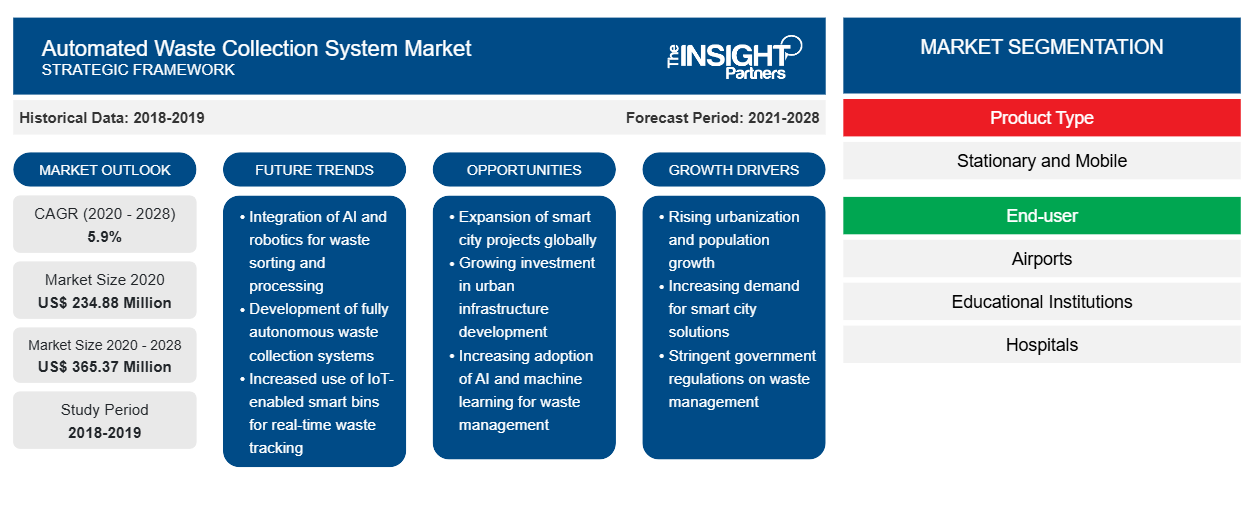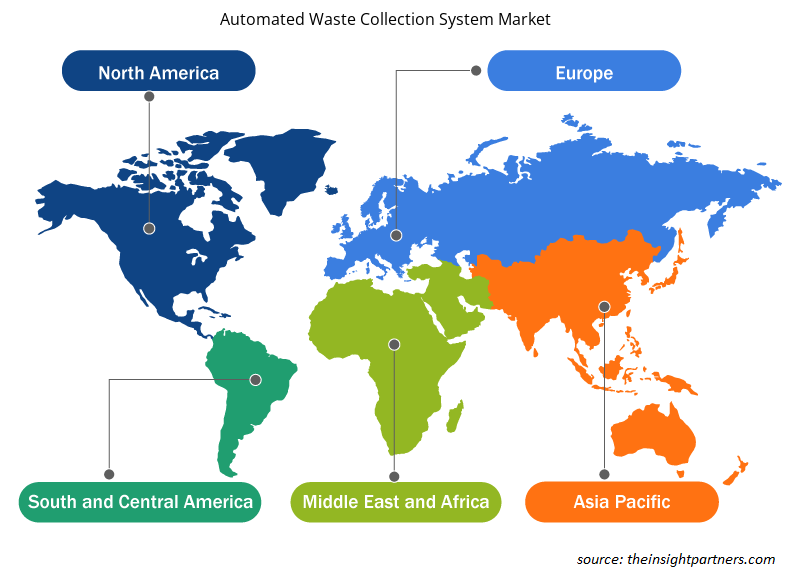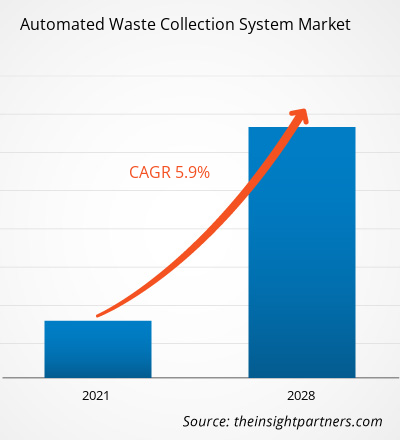The automated waste collection system market was valued at US$ 234.88 million in 2020 and is projected to reach US$ 365.37 million by 2028; it is expected to grow at a CAGR of 5.9% during 2021–2028.
The key factor driving the automated waste collection system market is the government initiatives for proper disposal of waste. Government bodies across the world have imposed rules and regulations for the collection and segregation of waste. For instance, the Government of India has specified new solid waste management rules emphasizing on the segregation of waste at source. The new regulations require waste to be separated at the source to channel it into capital through recovery, reuse, and recycling. Therefore, before handing over waste to the collectors, waste generators must sort it into three streams—biodegradables, dry (plastic, paper, metal, wood, etc.), and domestic hazardous waste (diapers, napkins, mosquito repellants, cleaning agents, etc.). However, the segregation of waste at a high scale is a tedious process, which is compelling government authorities to focus on automatic solutions of waste segregation. These factors are influencing the adoption of automated waste collection systems in many countries worldwide.
Customize This Report To Suit Your Requirement
You will get customization on any report - free of charge - including parts of this report, or country-level analysis, Excel Data pack, as well as avail great offers and discounts for start-ups & universities
Automated Waste Collection System Market: Strategic Insights

- Get Top Key Market Trends of this report.This FREE sample will include data analysis, ranging from market trends to estimates and forecasts.
You will get customization on any report - free of charge - including parts of this report, or country-level analysis, Excel Data pack, as well as avail great offers and discounts for start-ups & universities
Automated Waste Collection System Market: Strategic Insights

- Get Top Key Market Trends of this report.This FREE sample will include data analysis, ranging from market trends to estimates and forecasts.
Impact of COVID-19 Pandemic on Automated Waste Collection System Market
The automated waste collection system manufacturers across the globe, however experienced limited tremors as the regional and local governments encouraged municipalities and private organizations to invest toward smart and intelligent waste or garbage collection and sorting solutions. As the residential waste volumes increased substantially, the demand for automated waste collection systems among the residential sector soared. However, due to disruption in supply chain caused by the limitation of human movements, it resulted in slower deployment and installation of the AWCS in both developed and developing countries such as the US, Canada, the UK, Italy, and China. This followed slower than usual revenue growth trend in the global automated waste collection systems market
Market Insights–Automated Waste Collection System Market
Rising Investments in Integration of Automatic Waste Collection Systems
Automated waste collection systems are being highly preferred across healthcare institutions. The waste management and collection systems transfer materials at 60 miles per hour through a sealed, dedicated pipe network from loading stations on patient floors to a central collection operation. Separate paths are used to move waste, compost, and soiled linen to the appropriate collection bins. This is leading to the rise in investments in automatic collection technologies in industries such as hospitality, healthcare, and retail. For instance, Logiwaste AB has supplied three different automatic waste collection systems to Karolinska Hospital, Stockholm. These systems are projected to manage four different type of waste, namely, residual waste, paper, plastic, and paper packaging. Logiwaste AB has also won contracts from Tiller Öst, Trondheim; Karlstad Central Hospital; Grilstad Marina, Trondheim; and China Life, Beijing, to supply AWCS. Similarly, Atreo has received projects for supplying AWCS to Parkland Hospital, Humber River Hospital, Brigham and Women’s Hospital, and the University of Texas Southwestern Medical Center, among others. Thus, the rising investments by organizations from different industries, especially healthcare, to implement automatic waste collection and management systems is expected to fuel the growth of the market in the coming years.
Product Type-Based Insights
Based on product type, the automated waste collection systems market is segmented into stationary and mobile. The stationary segment held a larger market share in 2020.
Content Quality-Based Insights
Based on end-user, the automated waste collection systems market is segmented into airports, educational institutions, hospitals, corporate offices, hotels/restaurants, and others. The airports segment is projected to register the highest CAGR during the forecast period.
Players operating in the automated waste collection systems market are mainly focused on the development of advanced and efficient products.
- In 2021, Caverion implemented a turnkey project for a new building of the biotechnology company Thermo Fisher Scientific Baltics. The project took place in Vilnius, Lithuania.
- In 2021, Stavanger University Hospital selected automatic waste and laundry collection from Logiwaste AB. The system offers user-friendly, efficient and hygienic way of handling waste and laundry, from the inlet door all the way to the terminal.
Automated Waste Collection System Market Regional Insights
The regional trends and factors influencing the Automated Waste Collection System Market throughout the forecast period have been thoroughly explained by the analysts at The Insight Partners. This section also discusses Automated Waste Collection System Market segments and geography across North America, Europe, Asia Pacific, Middle East and Africa, and South and Central America.

- Get the Regional Specific Data for Automated Waste Collection System Market
Automated Waste Collection System Market Report Scope
| Report Attribute | Details |
|---|---|
| Market size in 2020 | US$ 234.88 Million |
| Market Size by 2028 | US$ 365.37 Million |
| Global CAGR (2020 - 2028) | 5.9% |
| Historical Data | 2018-2019 |
| Forecast period | 2021-2028 |
| Segments Covered |
By Product Type
|
| Regions and Countries Covered | North America
|
| Market leaders and key company profiles |
Automated Waste Collection System Market Players Density: Understanding Its Impact on Business Dynamics
The Automated Waste Collection System Market is growing rapidly, driven by increasing end-user demand due to factors such as evolving consumer preferences, technological advancements, and greater awareness of the product's benefits. As demand rises, businesses are expanding their offerings, innovating to meet consumer needs, and capitalizing on emerging trends, which further fuels market growth.
Market players density refers to the distribution of firms or companies operating within a particular market or industry. It indicates how many competitors (market players) are present in a given market space relative to its size or total market value.
Major Companies operating in the Automated Waste Collection System Market are:
- Aerbin APS
- AMCS Group
- Caverion Corporation
- Envac AB
- Logiwaste AB
Disclaimer: The companies listed above are not ranked in any particular order.

- Get the Automated Waste Collection System Market top key players overview
The automated waste collection system market has been segmented as follows:
Automated Waste Collection System Market– by Product Type
- Stationary
- Mobile
Automated Waste Collection System Market – by End-User
- Airports
- Educational Institutions
- Hospitals
- Corporate Offices
- Hotels / Restaurants
- Others
Automated Waste Collection System Market – by Geography
North America
- US
- Canada
- Mexico
Europe
- Germany
- France
- Italy
- UK
- Russia
- Rest of Europe
Asia Pacific (APAC)
- Australia
- China
- India
- Japan
- South Korea
- Rest of APAC
Middle East and Africa (MEA)
- Saudi Arabia
- UAE
- Rest of MEA
South America (SAM)
- Brazil
- Rest of SAM
Company Profiles
- Aerbin ApS
- AMCS Group
- Caverion Corporation
- Envac AB
- Logiwaste AB
- MariMatic Oy
- MEIKO
- Evac Group
- MABAT
- STREAM Environment
Frequently Asked Questions
What factors are providing opportunities for automated waste collection system market?
Automated waste collection systems are being highly preferred across healthcare institutions. The waste management and collection systems transfer materials at 60 miles per hour through a sealed, dedicated pipe network from loading stations on patient floors to a central collection operation. Separate paths are used to move waste, compost, and soiled linen to the appropriate collection bins. This is leading to the rise in investments in automatic collection technologies in industries such as hospitality, healthcare, and retail. For instance, Logiwaste AB has supplied three different automatic waste collection systems to Karolinska Hospital, Stockholm. These systems are projected to manage four different type of waste, namely, residual waste, paper, plastic, and paper packaging. Logiwaste AB has also won contracts from Tiller Öst, Trondheim; Karlstad Central Hospital; Grilstad Marina, Trondheim; and China Life, Beijing, to supply AWCS. Similarly, Atreo has received projects for supplying AWCS to Parkland Hospital, Humber River Hospital, Brigham and Women’s Hospital, and the University of Texas Southwestern Medical Center, among others. Thus, the rising investments by organizations from different industries, especially healthcare, to implement automatic waste collection and management systems is expected to fuel the growth of the market in the coming years.
Which factor is driving the Automated waste collection system market?
Government bodies across the world have imposed rules and regulations for the collection and segregation of waste. For instance, the Government of India has specified new solid waste management rules emphasizing on the segregation of waste at source. The new regulations require waste to be separated at the source to channel it into capital through recovery, reuse, and recycling. Therefore, before handing over waste to the collectors, waste generators must sort it into three streams—biodegradables, dry (plastic, paper, metal, wood, etc.), and domestic hazardous waste (diapers, napkins, mosquito repellants, cleaning agents, etc.). However, the segregation of waste at a high scale is a tedious process, which is compelling government authorities to focus on automatic solutions of waste segregation. These factors are influencing the adoption of automated waste collection systems in many countries worldwide.
Which product type led the Automated waste collection system market?
The stationary segment led the market in 2019 with highest share and is expected to continue its dominance during the forecast period. In stationary waste collection systems, the garbage is directly transported by pipes with the help of air pressure where it is compressed in seal containers. Thus, it is not required to be collected by trucks. Exhausters produce negative pressure in the pipe system, allowing air to flow freely. At ambient pressure, air enters the pipes, collecting the solid waste and carrying it to the collection station. The automated stationary waste collection systems can manage multiple waste forms simultaneously. In a standard collection method, two to four different waste streams are managed using the same transport pipes network.
- Historical Analysis (2 Years), Base Year, Forecast (7 Years) with CAGR
- PEST and SWOT Analysis
- Market Size Value / Volume - Global, Regional, Country
- Industry and Competitive Landscape
- Excel Dataset
Testimonials
Reason to Buy
- Informed Decision-Making
- Understanding Market Dynamics
- Competitive Analysis
- Identifying Emerging Markets
- Customer Insights
- Market Forecasts
- Risk Mitigation
- Boosting Operational Efficiency
- Strategic Planning
- Investment Justification
- Tracking Industry Innovations
- Aligning with Regulatory Trends
Yes! We provide a free sample of the report, which includes Report Scope (Table of Contents), report structure, and selected insights to help you assess the value of the full report. Please click on the "Download Sample" button or contact us to receive your copy.
Absolutely — analyst assistance is part of the package. You can connect with our analyst post-purchase to clarify report insights, methodology or discuss how the findings apply to your business needs.
Once your order is successfully placed, you will receive a confirmation email along with your invoice.
• For published reports: You’ll receive access to the report within 4–6 working hours via a secured email sent to your email.
• For upcoming reports: Your order will be recorded as a pre-booking. Our team will share the estimated release date and keep you informed of any updates. As soon as the report is published, it will be delivered to your registered email.
We offer customization options to align the report with your specific objectives. Whether you need deeper insights into a particular region, industry segment, competitor analysis, or data cut, our research team can tailor the report accordingly. Please share your requirements with us, and we’ll be happy to provide a customized proposal or scope.
The report is available in either PDF format or as an Excel dataset, depending on the license you choose.
The PDF version provides the full analysis and visuals in a ready-to-read format. The Excel dataset includes all underlying data tables for easy manipulation and further analysis.
Please review the license options at checkout or contact us to confirm which formats are included with your purchase.
Our payment process is fully secure and PCI-DSS compliant.
We use trusted and encrypted payment gateways to ensure that all transactions are protected with industry-standard SSL encryption. Your payment details are never stored on our servers and are handled securely by certified third-party processors.
You can make your purchase with confidence, knowing your personal and financial information is safe with us.
Yes, we do offer special pricing for bulk purchases.
If you're interested in purchasing multiple reports, we’re happy to provide a customized bundle offer or volume-based discount tailored to your needs. Please contact our sales team with the list of reports you’re considering, and we’ll share a personalized quote.
Yes, absolutely.
Our team is available to help you make an informed decision. Whether you have questions about the report’s scope, methodology, customization options, or which license suits you best, we’re here to assist. Please reach out to us at sales@theinsightpartners.com, and one of our representatives will get in touch promptly.
Yes, a billing invoice will be automatically generated and sent to your registered email upon successful completion of your purchase.
If you need the invoice in a specific format or require additional details (such as company name, GST, or VAT information), feel free to contact us, and we’ll be happy to assist.
Yes, certainly.
If you encounter any difficulties accessing or receiving your report, our support team is ready to assist you. Simply reach out to us via email or live chat with your order information, and we’ll ensure the issue is resolved quickly so you can access your report without interruption.















The List of Companies - Automated Waste Collection System Market
- Aerbin APS
- AMCS Group
- Caverion Corporation
- Envac AB
- Logiwaste AB
- Marimatic OY
- MEIKO
- EVAC GmbH
- MBAT
- Stream Environment






 Get Free Sample For
Get Free Sample For